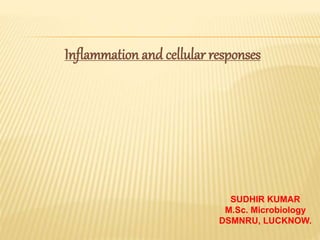
Inflammation and Cellular Responses
- 1. Inflammation and cellular responses SUDHIR KUMAR M.Sc. Microbiology DSMNRU, LUCKNOW.
- 2. Inflammation is a non specific, localized immune reaction of the organism, which tries to localized the pathogen agent. Many consider the syndrome a self-defense mechanism. It consist in vascular, metabolic, cellular changes, triggered by the entering of pathogen agent in healthy tissues of the body.
- 3. Is a protective response The body’s response to injury Types Acute (sec, mins, hrs) Chronic (days, weeks, months, yrs)
- 4. Celsus described the local reaction of injury to be known as the cardinal signs of inflammation. These signs are: rubor (redness) tumor (swelling) calor (heat) dolor (pain) functio laesa, or loss of function.
- 5. The basis of the five cardinal signs Increased blood flow due to vascular dilatation gives redness and heat. Increased vascular permeability gives edema causing tissue swelling. Certain chemical mediators stimulate sensory nerve endings giving pain. Nerves also stimulated by stretching from edema. Pain and swelling result in loss of function.
- 6. A.Exogenous causes: Physical agents Mechanic agents: fractures, foreign corps, sand, Thermal agents: burns, freezing,temprature. Chemical agents: -toxic gases, acids, bases Biological agent:-Bacteria,viruses,parasites B.Endogenous causes: Circulation,disorders-Thrombosis, infarction, hemorrhage Enzymes a,ctivation -Acute pancreatitis Metabolic products deposals -uric acid, urea
- 7. Vasoactive amines Histamine Serotonin (5-HT) Neuropeptides Substance P Plasma proteases and the complement system Action of Hageman factor Arachidonic acid metabolites Prostaglandins Leukotrienes Lipoxins Cytokines IL-1, TNF .
- 10. Chemokines (CXC and CC) Nitric oxide and oxygen-derived free radicals PREFORMED Histamine, Serotonin NEWLY SYNTHESISED Prostaglandins Leukotrienes Platelet activating factor Cytokines Nitric oxide LOCAL AND SYSTEMIC
- 11. The inflammatory reaction takes place at the microcirculation level and it is composed by the following changes: Tissue damage Cellular – vascular - cellular response Metabolic changes Tissue repair
- 13. Changes begin almost immediately after injury: Because of the pathogen agent action, in the affected tissue are released mediators responsible for the following events of inflammation. Tissue macrophages, monocytes, mast cells, platelets, and endothelial cells are able to produce a multitude of cytokines. The cytokines tissue necrosis factor-a (TNF-a) and interleukin (IL)–1 are released first and initiate several cascades.
- 14. TNF-a and IL-1 are responsible for fever and the release of stress hormones (norepinephrine, vasopressin, activation of the renin-angiotensin- aldosterone system). TNF-a and IL-1 are responsible for the synthesis of IL-6, IL-8, and interferon gamma. Cytokines, especially IL-6, stimulate the release of acute-phase reactants such as C-reactive protein (CRP). The proinflammatory interleukins either function directly on tissue or work via secondary mediators to activate the coagulation cascade, complement cascade, and the release of nitric oxide, platelet-activating factor, prostaglandins,
- 15. phase I = vasoconstriction (momentary constriction of small blood vessels in the area). Vascular spasm begins very quickly (30 sec.) after the injury at it last a few minutes. phaseII = activevasodilation Dilation of arterioles and capillaries (redness) Blood flow increases and gives pulsate sensation; Active hyperemia in skin territory and increased metabolism leads to higher local temperature (heat = calor).
- 16. phase III = passive vasodilation Blood vessels in the affected area loose their reactivity to nervous and humoral stimuli and passive vasodilation occurs. Progressively fluid move into the tissues (increased vascular permeability and structural alteration of blood vessels) and cause swelling (tumor), pain, and impaired function. As fluid moves out of the capillaries, stagnation of flow and clotting of blood in the small capillaries occurs at the site of injury.
- 17. The cellular response of acute inflammation is marked by movement of phagocytic white blood cells (leukocytes) into the area of injury. Two types of leukocytes participate in the acute inflammatory response - the granulocytes and monocytes. The sequence of events in the cellular response to inflammation includes: › pavementing › emigration › chemotaxis › phagocytosis
- 18. Protein metabolism › Is increased – cell destruction, metabolic products lead o increased osmotic pressure in interstitial space which attracts water and contributes to edema (swelling = tumor); › The metabolic changes, including skeletal muscle catabolism, provide amino acids that can be used in the immune response and for tissue repair; Glucose metabolism › Anaerobe utilization of glucose is increased because of hypoxia with increased formation of lactic and pyruvic acid; Lipid metabolism › Increased formation of ketons and fatty acids Mineral metabolism › Increased extracellular K+ concentration Acid – base balance › Metabolic acidosis (ketons, lactic acid)
- 19. The primary objective of the healing process is to fill the gap created by tissue destruction and to restore the structural continuity of the injured part. The effect of all this is restitutio ad integrum. Concomitantly with tissue damage, at the peripheral of inflammatory process, begins the repair process, in order to limit the extension of it. Reparatory processes: › Cell proliferation › Conjunctive tissue proliferation › Blood vessels neoformation = angiogenesis › Lymphatic drainage of exudates › Phagocytosis Injured tissues are repaired by regeneration of parenchymal cells or by connective tissue repair in which scar tissue is substituted for the parenchymal cells of the injured tissue (could lead to malfunction of organs - fibrosis).
- 20. Chemical mediators and growth factors orchestrate the healing process. › Some growth factors act as chemoattractants, enhancing the migration of white blood cells and fibroblasts to the wound site, and others act as mitogens, causing increased proliferation of cells that participate in the healing process (e.g. platelet-derived growth factor, which is released from activated platelets, attracts white blood cells and acts as a growth factor for blood vessels and fibroblasts). › Many of the cytokines discussed function as growth factors that are involved in wound healing.
